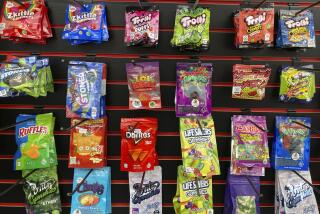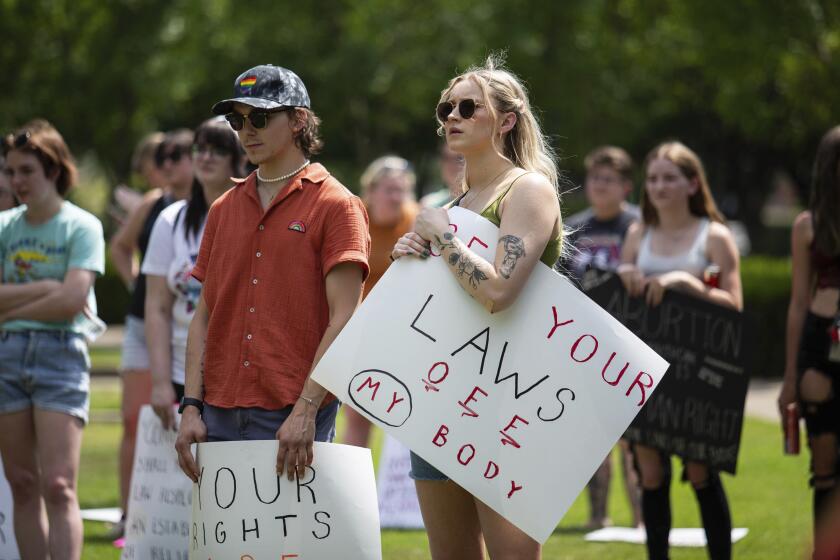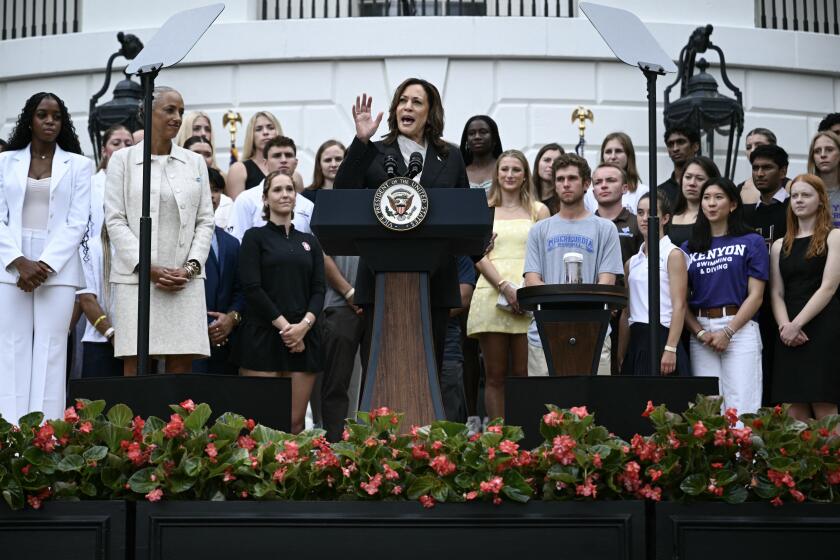Editorial: Billboards advertising pot broke Prop. 64’s promise. Don’t go back on the pledge to protect teens

Shielding teens from increased exposure to marijuana was a key selling point of the legalization plan California voters approved in 2016. The measure included “toughest-in-the-nation protections for children,” proponents said, by banning cannabis advertising aimed at those under age 21 and restricting where billboards can be placed.
Unfortunately, in the five years since voters passed Proposition 64, it’s been a nonstop game of whack-a-mole to try to keep the pot industry and cannabis regulators faithful to these promises. And success has been mixed.
For the record:
11:57 a.m. Jan. 3, 2022An earlier version of the editorial said the state Department of Cannabis Control reversed its rule allowing marijuana billboards on interstate highways. In fact, the state department was formed in July and its predecessor agency reversed the rule.
First, a prominent cannabis website found a loophole in the law and started throwing billboards up alongside major freeways, even though Proposition 64 says licensed marijuana businesses can’t advertise on billboards along interstate highways. How did Weedmaps get away with it? Turns out the $1.5-billion company isn’t a licensed cannabis business — it’s a website that advertises cannabis businesses. So the ban on advertising on interstate highway billboards does not apply.
Several lawmakers — including then-Assemblyman, now-Atty. Gen. Rob Bonta — wrote a bill to close that loophole in the billboard ban. But it never passed.
Then state cannabis regulators blew an even bigger hole in the freeway billboard ban. They claimed that the sentence in Proposition 64 that says licensed cannabis businesses can’t advertise on billboards “on an Interstate Highway or State Highway which crosses the border of any other state” was meant to discourage interstate commerce, not to prohibit advertising marijuana on interstate highways. In 2019, regulators passed a rule allowing legal pot businesses to advertise on billboards along interstate highways, as long as the signs were more than 15 miles from the state border — essentially making pot billboards permissible on almost every mile of freeway in California.
Predictably, the ads proliferated — until a San Luis Obispo man sued. Matthew Farmer, the father of two teenagers, argued in his lawsuit that state officials had illegally changed the law voters passed. His lawyers said Farmer voted for Proposition 64 with the understanding that it would prohibit advertising marijuana to minors and on heavily trafficked interstate highways, and that he grew concerned when cannabis billboards went up along the 101 Freeway his family routinely travels.
A judge agreed that state cannabis regulators had improperly allowed the billboards, in violation of Proposition 64’s advertising restrictions, and regulators yanked the rule.
But of course that wasn’t the last word. The cannabis industry flexed its lobbying muscle in Sacramento and pushed for a bill to unravel the judge’s order. Gov. Gavin Newsom had the good sense to reject it, recognizing, in his veto message, that when voters passed Proposition 64 “they enacted robust protections shielding youth from exposure to cannabis and cannabis advertising.”
Meanwhile, many communities are covered with pot billboards in locations that are allowed by Proposition 64 — which is anywhere more than 1,000 feet from a school, childcare center or playground, unless prohibited by a city or county.
And some of those ads are flirting with Proposition 64’s ban on advertising with “symbols, language, music, gestures, cartoon characters or other content elements known to appeal primarily” to people under age 21. One billboard features the word “Dank” spelled out in letters that look like sour gummy worms. Others reference cannabis “gushers” (a popular type of candy), or “lemonnade” (as if the double-n is a meaningful distinction), or feature a picture of a cartoon alien. But enforcement is lax. The Department of Cannabis Control relies on the public to report sketchy billboards, then decides whether to ask the advertiser to change them.
The cannabis industry argues that advertising is necessary to develop a robust legal marketplace that helps keep weed away from children. State-sanctioned dispensaries, they point out, only sell to adults — unlike black market drug dealers. If legal pot shops can’t advertise to attract more adult customers, the argument goes, they’ll have a hard time competing with the illicit market that many teens already have access to.
But health research supports limiting advertising. Teens who frequently see cannabis billboards and storefront ads are seven times more likely to use the drug weekly and six times as likely to have symptoms of cannabis addiction, compared with teens who never saw the ads, according to research published last year in the Journal of Studies on Alcohol and Drugs.
“There is something to seeing the billboards in your community that more effectively, perhaps, normalizes the use of cannabis,” said Alisa A. Padon, a research scientist at the Public Health Institute in Oakland.
Earlier research focused on Southern California teenagers found that “the more exposure young people have to marijuana advertising, the more likely they are to use the drug and to have positive views about it,” according to Elizabeth J. D’Amico, a senior behavioral scientist at the Rand Corp.
Her study found that a year after Californians passed Proposition 64, 70% of Southland teens had seen a medical marijuana ad during the previous three months — up from 25% of teens who had seen one several years earlier.
The trend is troublesome because teen brains are still developing, and research shows that using marijuana at an early age increases the likelihood of developing a problematic level of use. Studies show that frequent use by young people hurts their ability to think, learn and remember, and puts them at greater risk of mental illnesses, such as depression and schizophrenia.
Five years ago, The Times’ Editorial Board urged Californians to support Proposition 64 in part because it was supposed to help prevent teen use while making marijuana safer — and more just — for adults.
Like the alcohol and tobacco industries before it, the cannabis industry has since become a savvy political force in California, hiring well-connected lobbyists and pouring money into campaign coffers. And like their industry predecessors, marijuana mavens are using their clout to do what’s best for business, not what’s best for public health.
It’s up to Newsom, legislators and regulators to buck the industry pressure that favors more and more advertising. The governor, in particular, has an obligation to ensure the state upholds the promises of Proposition 64. As lieutenant governor, he led a commission to study marijuana policy issues, which put public health front and center, and he campaigned for Proposition 64 two years later. Lawmakers should not entertain any more legislation to expand cannabis advertising. In fact, they should consider whether it makes sense to require warning labels on cannabis billboards, similar to the ones on alcohol and tobacco ads. Regulators should use their authority to crack down on existing billboards that target youth, without waiting for complaints from the public to come in.
Voters bought the argument that Proposition 64 would shield California kids from marijuana advertising. Don’t go back on that promise.
More to Read
A cure for the common opinion
Get thought-provoking perspectives with our weekly newsletter.
You may occasionally receive promotional content from the Los Angeles Times.






